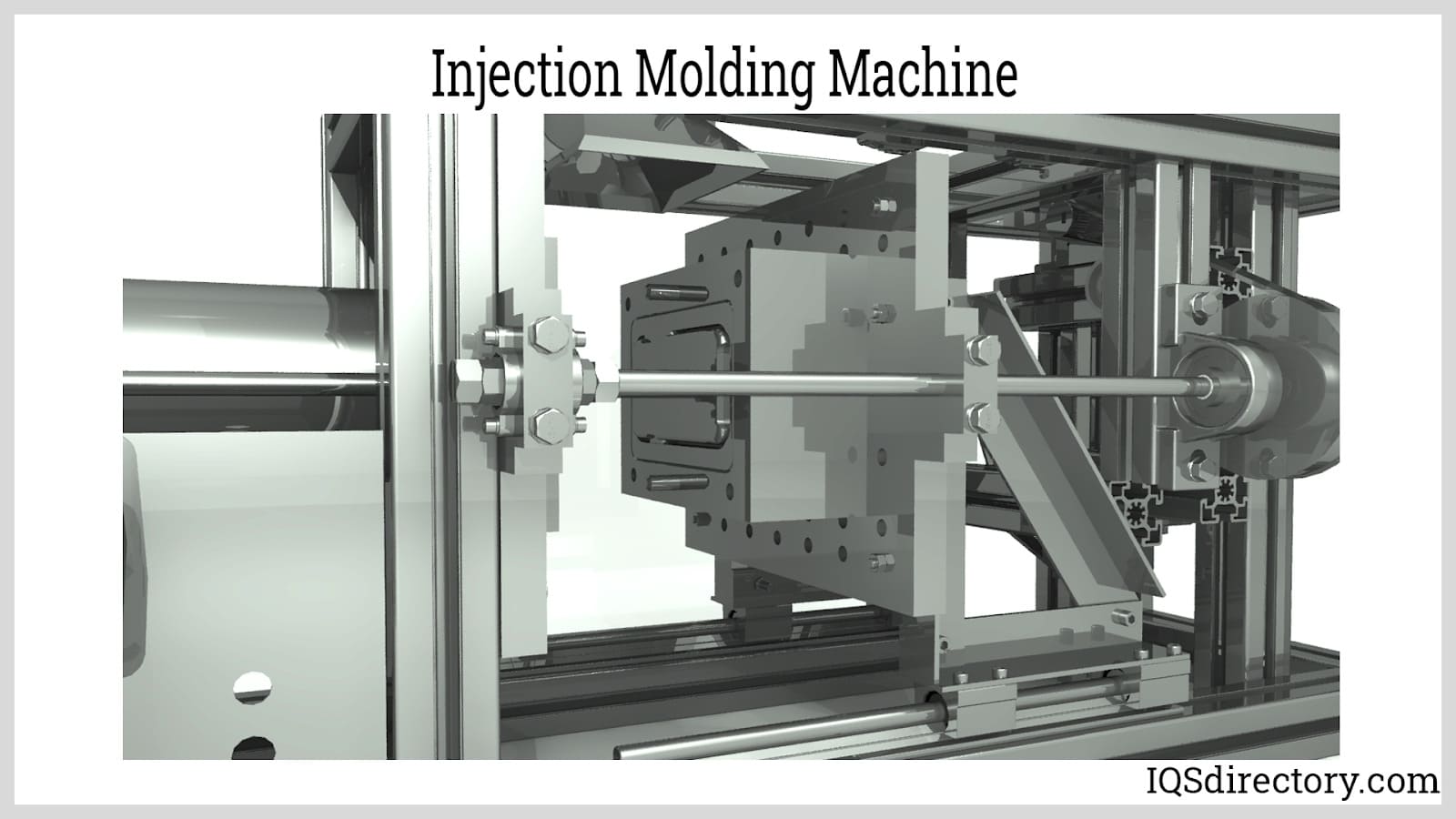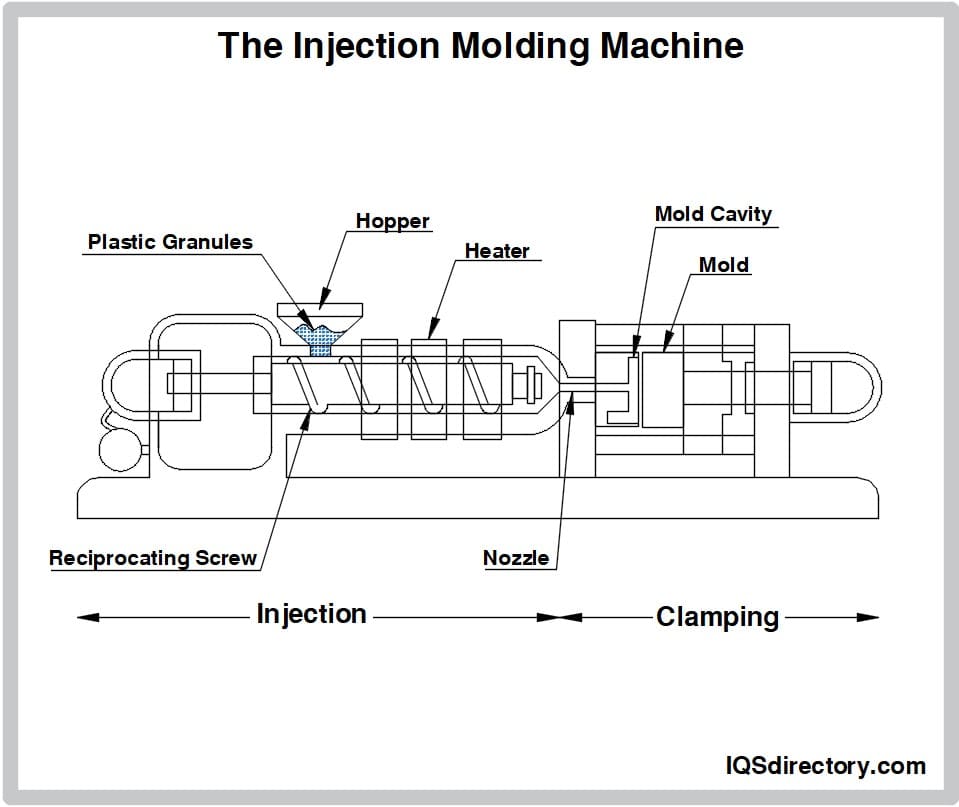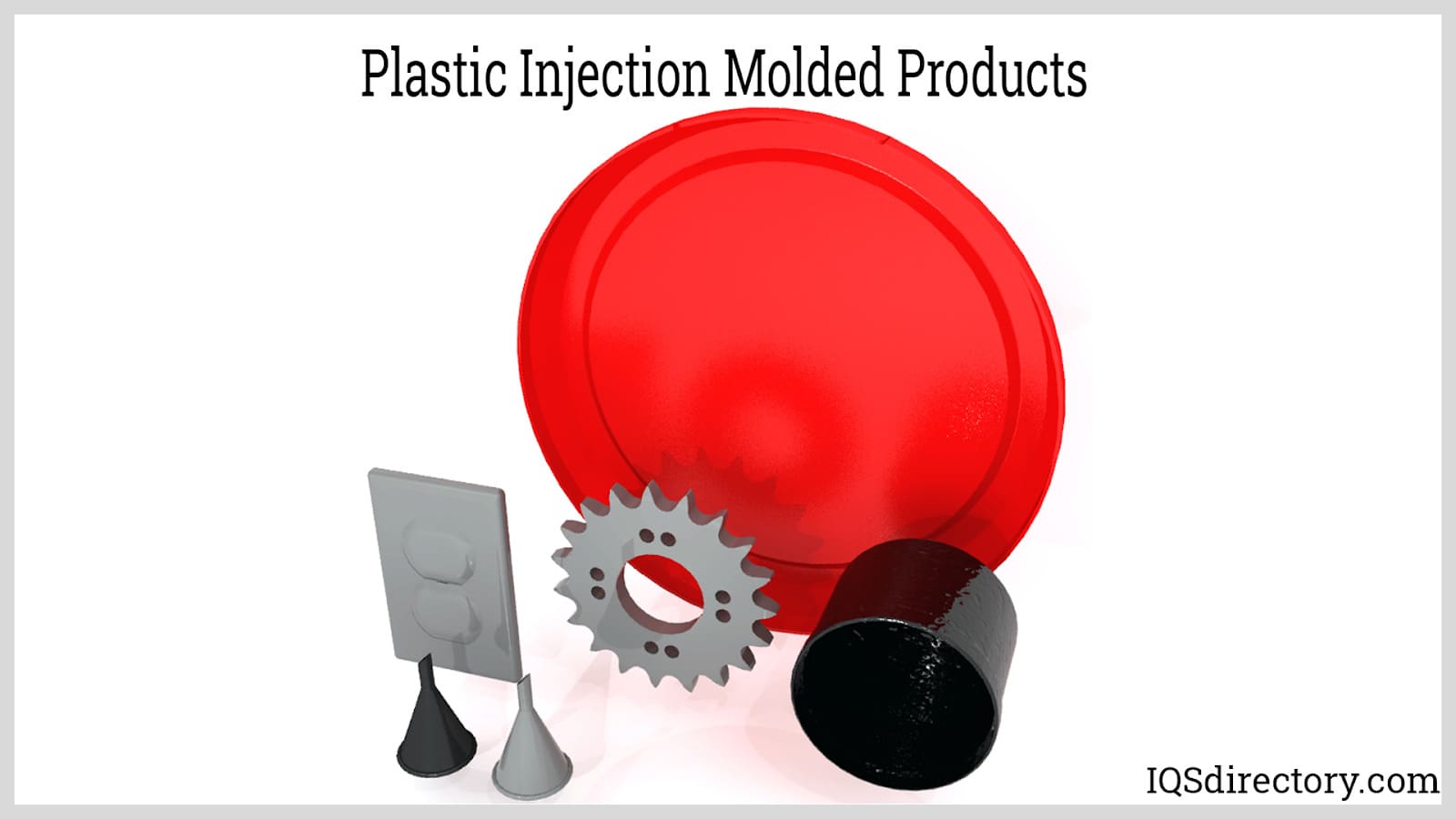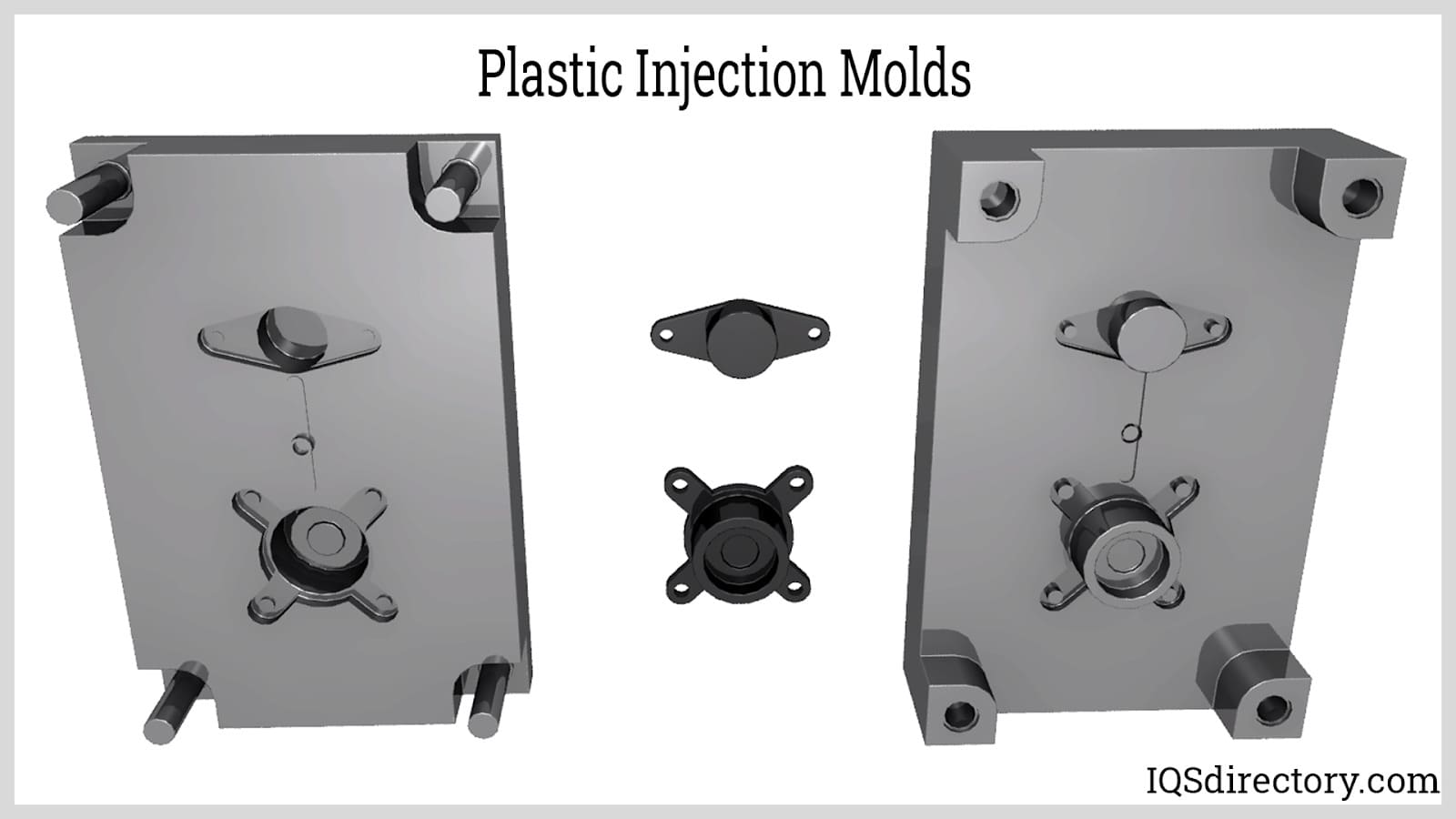Injection Molded Plastics
Injection molding is a highly efficient manufacturing process used to produce parts by injecting material into a mold. The process begins when the chosen material is poured or pumped into a heated barrel, where it is thoroughly mixed to achieve a uniform consistency. Once the material reaches the ideal state, it is forced into the mold cavity under high pressure. There, it cools and hardens, taking on the precise shape of the mold until the final piece is fully solidified.
This method is particularly advantageous for manufacturers requiring high-volume production of identical parts. Its precision and consistency make it invaluable for applications demanding extremely low tolerances, as injection molding achieves an exceptionally low parts-per-million defect rate.
One of the key benefits of injection molding is its ability to create parts with intricate details that would be difficult or impossible to achieve by hand. Because the molds can be designed with highly complex geometries, manufacturers can produce components with fine features and tight tolerances. Every mold is meticulously crafted using 3D modeling software, allowing engineers complete control over every dimension of the final product, ensuring accuracy and repeatability.
The efficiency and cost-effectiveness of injection molding make it a preferred choice across a vast range of industries, from automotive and furniture manufacturing to musical instruments and consumer goods. This process plays a crucial role in the production of everyday items, seamlessly integrating into nearly every aspect of modern life.
Common products created through injection molding include flutes, one-piece chairs, storage containers, wire spools, bottle caps, pocket combs, plastic cups, and countless other essential items.
Injection Molded Plastics FAQs
What is the injection molding process?
Injection molding is a manufacturing process where molten plastic is injected into a mold cavity, cooled, and solidified into a precise shape. It’s widely used for producing high volumes of identical parts with exceptional consistency and tight tolerances.
What are the main advantages of injection molding?
Injection molding offers high efficiency, low defect rates, and excellent precision. It’s ideal for mass production of complex components, reducing material waste and ensuring consistent quality across large runs of identical parts.
Which materials are commonly used in injection molding?
Common materials include thermoplastics like polyethylene, polypropylene, nylon, and polystyrene, as well as thermosets and elastomers. Each material offers distinct advantages in strength, flexibility, heat resistance, and recyclability.
What are some common products made with injection molding?
Injection molding is used to produce items such as bottle caps, storage containers, plastic cups, flutes, and furniture components. It’s essential to industries including automotive, medical, and consumer goods manufacturing.
How has injection molding evolved over time?
Developed in 1872 by John Wesley Hyatt, injection molding evolved significantly after the invention of the screw injection machine in 1946. Modern systems allow precise control, automated mixing, and use of recycled materials for improved quality and efficiency.
What are some specialized types of injection molding?
Specialized methods include gas-assist molding, insert molding, overmolding, double-shot molding, and reaction injection molding. These techniques enable multi-material designs, lightweight parts, and enhanced product performance.
What design factors are critical in injection molding?
Wall thickness, cavity precision, and material flow are vital design factors. Properly engineered molds ensure even pressure distribution, prevent defects, and produce parts with reliable structural integrity and consistent quality.
Why is injection molding popular among U.S. manufacturers?
Manufacturers across the U.S. rely on injection molding for its scalability, cost-effectiveness, and precision. It supports high-volume production of durable plastic parts essential to automotive, industrial, and consumer markets.
The History of Injection Molding
- The Origins of Injection Molding
- The injection molding process was first developed by John Wesley Hyatt and his brother Isaiah in 1872. Their early design was a rudimentary version of today’s sophisticated injection molding machines. Functioning much like a large hypodermic needle, their device relied on a plunger to force plastic through a heated barrel and into a hand-ground steel mold. This initial process was limited in its capabilities, producing only simple items such as buttons, combs, and collar stays.
- The Evolution of the Molding Process
-
Following its inception, injection molding evolved gradually. A significant breakthrough occurred in 1903 when German chemists Arthur Eichengrun and Theodore Becker developed the first soluble forms of cellulose acetate, a less flammable alternative to cellulose nitrate, which had previously been the standard material. The introduction of cellulose acetate in powder form made it easier to transport and distribute, further advancing the industry.
In 1919, Arthur Eichengrun patented a refined version of the injection molding process based on what would become the first modern injection molding machine. However, it was not until World War II that the industry experienced rapid advancements due to the demand for mass-produced, cost-effective goods. In 1946, American inventor James Watson Hendry revolutionized injection molding by developing the first screw injection machine. This innovation provided precise control over the injection rate, significantly improving the quality and consistency of molded products while reducing production errors.
- Hendry’s screw injection machine also introduced a new capability: mixing raw materials before injection. This allowed for the integration of colorants and recycled plastics, ensuring a uniform composition before the material entered the mold. These advancements paved the way for injection molding to become a dominant manufacturing process across a wide range of industries.
Injection Molded Plastic Types
- Custom Injection Molding
- A specialized injection molding process where the mold is designed and manufactured specifically to meet the customer’s application requirements, rather than using pre-made molds.
- Double-Shot Molding
- A two-step process where one color or material is injected first, followed by a second color or material after the initial component has hardened. This method allows for multi-material or multi-color molded products in a single operation.
- Gas-Assist Injection Molding
- An advanced molding process where inert gas, such as nitrogen, is introduced into the molten plastic during injection. The gas forces the material into the mold cavities, reducing cycle time, part weight, warpage, and residual stress while improving dimensional stability.
- Injection Blow Molding
- A manufacturing process that begins with the injection of plastic into a mold to form a preform tube. This tube is then transferred to a second mold, where it is inflated to create a hollow component. This technique is widely used for producing bottles and other thin-walled plastic containers.
- Injection Molding
- A highly efficient process in which molten plastic is injected into a mold cavity to produce plastic parts and products with high precision and consistency.
- Injection Moulders
- The machines, tools, and dies used to shape molten plastic into finished parts through the injection molding process.
- Injection Molded Cases
- Rugged and durable plastic carrying cases designed to transport and protect delicate or valuable equipment from impact, moisture, and other environmental hazards.
- Injection Molded Parts
- Various plastic components produced through injection molding, ranging from small intricate pieces to large structural elements, utilized in countless industries and applications.
- Insert Molding
- A technique where plastic is injected around an insert component, such as metal or another material, creating a single integrated piece. This process enhances the strength and functionality of the final product.
- Molded Plastic Pieces
- Plastic components formed by heating plastic material until it becomes pliable and pressing it into molds, ensuring precise dimensions and consistent quality.
- Plastic Injection Mold Processes
- A set of manufacturing methods used to produce plastic parts of varying complexity, from simple shapes to highly precise components with intricate geometries.
- Plastic Molding
- One of the most widely used part manufacturing methods, allowing for mass production of durable plastic components with consistent quality.
- Push-Pull Molding
- A molding technique that incorporates multiple layers of material with different orientations, resulting in more uniform mechanical properties compared to single-direction molded parts.
- Prototype Injection Molding
- A method used to produce small batches of injection-molded parts for prototype development, enabling engineers to test and refine designs before full-scale production.
- Rapid Injection Molding
- A fast and cost-effective process ideal for prototyping and low-volume production, significantly reducing lead times compared to traditional injection molding.
- Reaction Injection Molding
- A specialized technique used for producing large, complex polyurethane plastic and rigid foam parts in small quantities, offering an economical alternative for low-volume applications.
- Thermoplastic Injection Molding
- The most common injection molding method for processing thermoplastics, allowing for the fabrication of parts with a broad range of design complexities, from basic shapes to highly intricate and precise geometries.
Materials and Properties of the Injection Molding Process
- Materials Utilized In the Injection Molding Process
- The injection molding process accommodates a vast range of custom plastic materials, with the choice of material depending on the intended function of the finished product. Since 1995, the number of available custom plastics has grown by approximately 750 new materials each year, a sharp increase from the 18,000 options available when this trend first began.
- Injection molding materials generally fall into one of three primary categories: thermoplastics, thermosets, or elastomers. Mechanical and material engineers carefully evaluate the characteristics of each material type, weighing factors such as strength, chemical resistance, and the product’s intended lifespan before selecting the most suitable option for production.
- Commonly used plastics in injection molding include nylon, polyethylene, polystyrene, epoxy, and phenolic. Each of these materials offers unique advantages depending on the specific requirements of the molded component. For those interested in exploring polyethylene plastic producers, IQS Directory provides a comprehensive list of manufacturers.
- Manufacturers are not constrained by material limitations when it comes to injection molding. This process enables the fabrication of an extensive variety of shapes and sizes, from large automotive bumpers to intricate components for medical equipment. If a mold can be designed for an object, the injection molding process can be used to bring it to life by melting the appropriate material, injecting it into a pre-formed cavity, and allowing it to cool and solidify.
- The Properties of Materials Used In the Process
- As mentioned earlier, the plastics used in injection molding are categorized into thermoplastics, thermosets, and elastomers, each offering distinct advantages based on their molecular composition and behavior during processing.
- Thermoplastics, such as polyethylene, consist of high-molecular-weight polymer chains that associate through intermolecular forces. This structure allows thermoplastics to be heated into a molten state with relatively low amounts of energy. Once cooled, these materials can be re-melted and reshaped without degradation, making them highly cost-efficient and ideal for applications where recyclability and reusability are key considerations.
- Thermosets, by contrast, undergo a one-time curing process in which they transition from a liquid to a solid state, forming an irreversible polymer network. Once set, thermosets cannot be remelted or reshaped. However, this limitation is also their greatest advantage—materials such as epoxy exhibit exceptional durability and resistance to high temperatures and chemical exposure, making them ideal for applications requiring long-term structural integrity.
- Elastomers, which include materials like nylon, exist in a state of viscoelasticity, meaning they combine the flexibility of a fluid with the resilience of a solid. Their unique ability to deform under stress and return to their original shape without permanent alteration makes elastomers highly versatile. Rubber, the most well-known elastomer, exemplifies the benefits of this material class, offering both durability and adaptability across a wide range of applications.
- With each of these material types offering distinct advantages, injection molding remains one of the most flexible and widely used manufacturing processes in modern industry. Whether producing rigid, high-strength components, heat-resistant parts, or flexible, impact-resistant materials, the adaptability of injection molding ensures that virtually any design requirement can be met with precision and efficiency.
Injection Molding Process
The plastic injection molding process begins with raw material in pellet form. These pellets are fed through a hopper into a heated barrel, where a reciprocating screw continuously moves them forward. As the pellets pass through the barrel, they are subjected to increasing temperatures, causing them to melt and become more viscous. At this stage, dyes or other chemical additives may be introduced to modify the final product’s appearance, texture, or other physical properties.
Once the plastic reaches the desired consistency, it moves through a check valve and accumulates at the front of the screw. The screw is specifically engineered to collect precisely the amount of material required to fill the mold. When ready, the screw pushes the molten plastic into the injection mold, where it is evenly distributed throughout the cavity. Most molds are designed with vents to allow trapped air to escape, preventing defects in the finished product. To accelerate the cooling process, cooling liquids circulate around the mold chamber, efficiently extracting heat from the molten plastic and reducing cycle times. Depending on the complexity of the component, this phase can take anywhere from a few seconds to several minutes.
As the plastic solidifies, the screw retracts to prepare for the next cycle, gathering new material for the subsequent injection. Cooling lines, typically filled with water or another coolant, run along the mold walls to ensure rapid and uniform cooling. Once the material has hardened, ejector pins engage, releasing the completed plastic component from the mold, ready for further processing or assembly.
- How the Injection Molding Process Can Be Customized
- The injection molding process can be adapted in various ways to enhance efficiency and precision. One widely used customization technique is robotic molding, which incorporates small robotic arms and advanced sensors to inspect each molded component for potential defects. This automation ensures a consistently high level of quality by detecting imperfections before they reach the next stage of production.
- Another customization method involves modifying the insert molding material. By switching from steel inserts to resin inserts, manufacturers can significantly improve the flow rate of the molten plastic, increasing production output. However, this adjustment comes with trade-offs, as higher flow speeds can increase the likelihood of defects. Because of this, any such tooling modifications should be implemented only after careful evaluation and approval by a qualified engineer.
- Drawbacks of the Injection Molding Process
- Despite its many advantages, the injection molding process does have limitations. One major drawback is that it is exclusively suited for producing plastic components. Manufacturers seeking to produce metal or other non-plastic parts must turn to alternative manufacturing methods, such as die-casting or CNC machining.
- Additionally, the injection molding process requires a substantial upfront investment. Designing and fabricating a mold is an expensive and time-intensive undertaking, requiring meticulous planning and precision engineering. However, once the mold is completed and production begins, the process becomes highly cost-effective, particularly for large-scale manufacturing. The initial expense is offset by the long-term benefits of rapid production speeds, high repeatability, and minimal material waste, making injection molding an ideal solution for high-volume production needs.
Important Design Elements to Consider for Injection Molding
One of the most critical design factors in the custom injection molding process is the wall thickness of the mold. This parameter plays a crucial role in ensuring a successful molding operation, as the entire process relies heavily on the mold cavity and the precision of its tolerances. The mold cavity must be carefully designed to facilitate the correct flow of molten material; any miscalculations in its dimensions can lead to significant production issues. If the cavity is not engineered with the proper specifications, the injection process may lack the necessary pressure to distribute the material evenly, resulting in incomplete fills, weak structural integrity, and defects in the final molded component.
Injection Molding Images, Diagrams and Visual Concepts
 An injection molding machine used to mold plastic in to different products.
An injection molding machine used to mold plastic in to different products.
 An injection molding machine diagram and the different parts necessary for injection molding.
An injection molding machine diagram and the different parts necessary for injection molding.
 Examples of different products made from plastic injection molding.
Examples of different products made from plastic injection molding.
 A reactive molding process that utilizes low viscosity liquid thermoset polymers.
A reactive molding process that utilizes low viscosity liquid thermoset polymers.
 Plastic injection molds shapes the molten plastic into the final form of the plastic.
Plastic injection molds shapes the molten plastic into the final form of the plastic.
The Types of Equipment Used for the Injection Molding Process
Custom injection molding relies on several essential pieces of tooling equipment to ensure precision, efficiency, and consistency in production. Among the most commonly used components are the injection ram, which drives material into the mold, and the screw-type plunger, which facilitates the controlled flow and mixing of molten plastic. Additional key equipment includes insert molding tools, used for integrating multiple materials into a single molded component, and a process heating unit, which maintains the required temperature for optimal material viscosity. The material hopper plays a crucial role by feeding plastic pellets into the system for melting and injection.
Injection molding presses are classified based on their tonnage, which indicates the machine’s clamping force and production capacity. The tonnage of these presses varies widely, ranging from small-scale units rated at 1 ton to industrial-grade machines exceeding 10,000 tons, allowing manufacturers to produce everything from intricate precision components to large structural parts.
How to Choose the Right Molding Manufacturer
With numerous injection molding manufacturers available, selecting the one best suited to your specific needs can be challenging. While many manufacturers excel in the industry, their expertise does not always align with every project’s unique requirements. Identifying the right partner involves evaluating key factors that directly impact the quality, efficiency, and scalability of your production.
One of the most critical considerations is the range of press sizes a manufacturer offers. The ability to work with a variety of press sizes indicates greater flexibility in accommodating different part dimensions, material types, and production volumes. A manufacturer with a diverse selection of press sizes can more easily adapt to specific project requirements, ensuring access to a broader selection of injection molding materials, colors, and customization options, while also reducing the need to coordinate with multiple vendors.
Another essential factor is the manufacturer’s ability to scale production. If your demand for parts increases unexpectedly, your chosen manufacturer must be equipped to expand operations seamlessly. A facility with sufficient capacity, advanced automation, and adaptable production lines will be better suited to meet growing demand without compromising quality or lead times.
For a comprehensive list of manufacturers, refer to the directory at the top of this page.
Injection Molded Plastic Terms
- Backing Plate
- A structural plate that provides essential support for the mold cavity block, guide pins, bushings, and other components within the mold assembly.
- Cavity
- The internal space within a mold where molten material is injected and shaped into the desired part.
- Charge
- The precise amount of material required to completely fill a mold during a single injection molding cycle.
- Cooling Channels
- Internal passages within the mold through which a cooling medium, such as water or oil, flows to regulate the temperature of the mold surface, ensuring uniform cooling and minimizing defects.
- High Density Polyethylene (HDPE)
- A durable plastic commonly used for packaging short-shelf-life products, including milk, juice, water, and laundry detergent bottles. Unpigmented HDPE bottles are translucent and known for their excellent stiffness.
- Hydraulic Units
- Devices that utilize pressurized fluid to control and move the mold components during the injection molding process, ensuring smooth operation and consistent cycle times.
- Linear Low Density Polyethylene (LLDPE)
- A tough and flexible plastic primarily used in film applications, such as grocery bags, garbage bags, and landfill liners. LLDPE is preferred in injection molding due to its superior toughness and adaptability.
- Mold
- A precisely engineered assembly of steel plates containing cavities where molten plastic resin is injected and shaped into the final part.
- Monomer
- A simple molecular compound that serves as the building block for forming long-chain polymers through chemical reactions.
- Melt Index
- A standardized test used to measure the ease with which molten plastic flows under specific conditions, providing insight into material processing characteristics.
- Melting Point (Tm)
- The temperature at which the crystalline regions of a polymer transition from a solid to a molten state, rendering the material completely amorphous and ready for processing.
- Melt Viscosity
- A measure of a material's resistance to flow in its molten state. Higher temperatures typically result in lower viscosity, allowing for easier processing.
- Polymer
- A molecular structure consisting of numerous repeating units (monomers) linked together in chains, giving rise to distinct material properties used in various applications.
- Polypropylene (PP)
- A strong and lightweight plastic with the lowest density among packaging materials. Due to its high melting point, polypropylene is ideal for hot-fill liquid applications and food storage containers.
- Polystyrene (PS)
- A versatile plastic available in both rigid and foamed forms. General-purpose polystyrene is clear, hard, and brittle, with a relatively low melting point, making it suitable for a wide range of packaging and disposable applications.
- Resin
- A class of solid or semi-solid organic substances, either naturally occurring or synthetically produced, characterized by high molecular weight and an undefined melting point. Most resins are polymers used in molding and fabrication processes.
- Thermoplastics
- A category of materials that can be repeatedly melted and solidified without significant degradation. Thermoplastics can be blended through melt-mixing, offering versatility in material properties and applications.
- Thermosets
- Materials that undergo an irreversible chemical curing process when heated, forming a rigid, heat-resistant structure. Unlike thermoplastics, thermosets do not melt when exposed to heat, making them ideal for high-temperature applications.
- Toggle Unit
- A mechanical system composed of linked levers used to move and apply pressure to the mold during the injection molding process, ensuring precise and repeatable part formation.
- Overmolding
- A specialized injection molding process that involves molding one material over another, effectively combining two materials into a single component. This two-step process enhances product durability and reliability, making it suitable for applications requiring improved grip, shock absorption, or structural reinforcement.